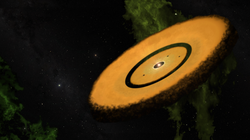| Observation data Epoch J2000 Equinox J2000 | |
|---|---|
| Constellation | Carina |
| Right ascension | 08h 08m 22.18s[1] |
| Declination | −64° 43′ 57.3″[1] |
| Characteristics | |
| Evolutionary stage | red dwarf |
| Spectral type | M5.5V[2] |
| Astrometry | |
| Radial velocity (Rv) | 22.7 ± 0.5[1] km/s |
| Proper motion (μ) | RA: −11.54±0.12[1] mas/yr Dec.: 25.61±0.10[1] mas/yr |
| Parallax (π) | 9.8599±0.0551[3] mas |
| Distance | 331 ly (101.4 ± 0.6[1] pc) |
| Details | |
| Mass | 0.16+0.03 −0.04[1] M☉ |
| Temperature | 3050 ± 100[1] K |
| Age | 45+11 −7[4] Myr |
| Other designations | |
WISE J080822.18-644357.3 | |
| Database references | |
| SIMBAD | data |
WISE J080822.18-644357.3, also called J0808, is a 45+11
−7 Myr old[4] star system in the Carina constellation with a circumstellar debris disk orbiting an M-type red dwarf about 331 lightyears from Earth.
On October 21, 2016, NASA's Goddard Space Flight Center announced that its citizen science project, Disk Detective, discovered a debris disk around J0808, using the WISE telescope, a M5.5V dwarf with significant infrared excess at both 12 and 22 μm. Classified as Peter Pan disk number AWI0005x3s in the project database—or 5x3s for short—a BANYAN II Bayesian analysis revealed (with 93.9% probability) the star's radial velocity as 20.6 ± 1.4 km/s, associating it with Carina's ~45 Myr old young moving group. Since most M-dwarf debris disks fade in less than 30 million years, this would be the oldest M dwarf debris disk detected in a moving group, implying a change in understanding of constraint in M-dwarf debris disk evolution.[5][2]
A follow-up study with an optical spectrum obtained with the ANU Siding Spring 2.3 meter telescope showed a Li-rich M5-star with strong Hα emission. The data is consistent with a low accretion of 10−10 M☉ yr −1.[6] ALMA observations did not detect any carbon monoxide, but unresolved 1.3 mm dust emission was detected.[1] Observations with CTIO showed a strong flare and variations in the Paschen-β and Brackett-γ lines, which is a clear sign of accretion.[7]
- ^ a b c d e f g h i Flaherty, Kevin; Hughes, A. Meredith; Mamajek, Eric E.; Murphy, Simon J. (2019-02-13). "The Planet Formation Potential around a 45 Myr Old Accreting M Dwarf". The Astrophysical Journal. 872 (1): 92. arXiv:1812.04124. Bibcode:2019ApJ...872...92F. doi:10.3847/1538-4357/aaf794. ISSN 1538-4357. S2CID 119251811.
- ^ a b Silverberg, Steven M.; Kuchner, Marc J.; Wisniewski, John P.; Gagné, Jonathan; Bans, Alissa S.; Bhattacharjee, Shambo; Currie, Thayne R.; Debes, John R.; Biggs, Joseph R. (14 October 2016). "A New M Dwarf Debris Disk Candidate in a Young Moving Group Discovered with Disk Detective". The Astrophysical Journal. 830 (2): L28. arXiv:1610.05293. Bibcode:2016ApJ...830L..28S. doi:10.3847/2041-8205/830/2/L28. ISSN 2041-8205. S2CID 119183849.
- ^ Gaia Collaboration (2018-08-01). "Gaia Data Release 2 - Summary of the contents and survey properties". Astronomy & Astrophysics. 616: A1. arXiv:1804.09365. Bibcode:2018A&A...616A...1G. doi:10.1051/0004-6361/201833051. ISSN 0004-6361. S2CID 49211658.
- ^ a b Bell, Cameron P. M.; Mamajek, Eric E.; Naylor, Tim (2015-11-21). "A self-consistent, absolute isochronal age scale for young moving groups in the solar neighbourhood". Monthly Notices of the Royal Astronomical Society. 454 (1): 593–614. arXiv:1508.05955. Bibcode:2015MNRAS.454..593B. doi:10.1093/mnras/stv1981. ISSN 0035-8711. S2CID 55297862.
- ^ Ramsey, Sarah (2016-10-21). "Citizen Scientists Discover Potential New Exoplanet Hunting Ground". NASA. Retrieved 2020-01-08.
- ^ Murphy, Simon J.; Mamajek, Eric E.; Bell, Cameron P. M. (2018-05-21). "WISE J080822.18−644357.3 – a 45 Myr-old accreting M dwarf hosting a primordial disc". Monthly Notices of the Royal Astronomical Society. 476 (3): 3290–3302. arXiv:1703.04544. Bibcode:2018MNRAS.476.3290M. doi:10.1093/mnras/sty471. ISSN 0035-8711. S2CID 119341475.
- ^ Cite error: The named reference
:1was invoked but never defined (see the help page).
